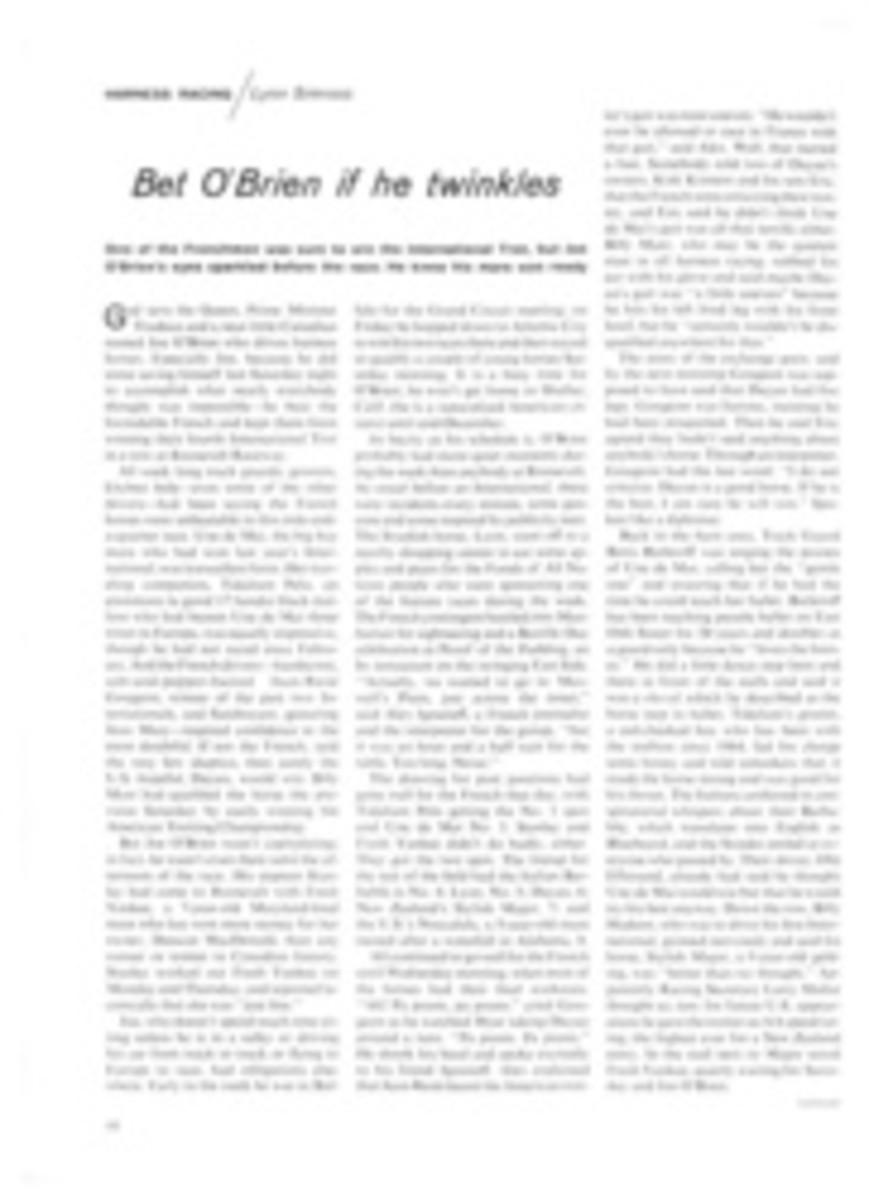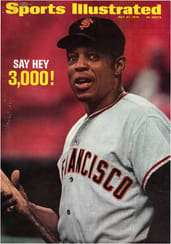
END OF A LONG, LONG DROUGHT
It seemed to be all over. Standing on the last green of the 1970 British Open at St. Andrews, I surveyed my second putt, stroked it and watched it roll just past the hole. Just as it died, I heard a roar coming from the direction of the 17th green, and I knew that Doug Sanders, who was now leading me by a shot, had parred the hole. I was completely dejected. My caddie had tears in his eyes. Neither of us imagined Sanders would make anything worse than par on the 18th. I walked over and tapped in my third putt (I had three-putted three of the last five holes), then headed toward the scorer's table.
After signing my card, I went into Keith Mackenzie's trailer to watch Sanders play the last hole on television. Someone said he had hit the ball 35 feet past the pin on his approach. I decided to go out and watch him finish and then congratulate him on winning the Open. I saw Doug's first putt stop about three feet short of the cup. Tony Jacklin, who was standing next to me, whispered, "Hey, Jack, you're still alive." Meanwhile, Gerald Micklem of the Royal and Ancient was talking to my wife Barbara.
"I placed the pins myself this morning," he told her. "That is a very difficult putt for Sanders. It looks straight, but it breaks to the right. You cannot read it. More to the right and he could read it. But not there."
Sure enough, when he putted, Doug didn't allow for the strong break the ball took to the right. The putt never even touched the hole and, incredibly, I was alive again.
Three-putt greens almost ruined me at St. Andrews this year, and I am not consoled by the fact that someone else's third putt on the final regulation hole put me into the playoff I ultimately won. Apart from the huge St. Andrews greens, which total around six acres (compared to a little over three acres on the average American course), St. Andrews threw something else at us this year that further complicated our putting problems. The wind.
On hitting an approach to the greens, you were tempted to run after it with a coin in your hand so you could mark it before the wind began blowing the ball away. Preparing to play your putt, you did not study the contours of the green; instead, you checked the wind. A putt might break three feet right to left, but if the wind was blowing from left to right, you played your putt left to right also.
Sometimes it was even tough to get comfortable over your putts, particularly for more deliberate players like myself. I was always 10th to set my putter head behind the ball, for fear the wind would move it while the club was grounded, which costs you a stroke. When you pulled the putter back, the wind would actually move it off the line of the putt an inch or more. Players were stabbing the tops of their golf balls almost as often as they were hitting them smoothly. Lee Trevino, who is particularly fast around the greens, putted superbly for the first three rounds at St. Andrews, but then on the fourth day he seemed to get cautious, which probably hurt him. At least that seems a reasonable explanation why a good putter like Lee three-putted seven greens on the last round.
But if putting was the key to victory at St. Andrews, then tradition was what made it all worthwhile. When it comes to golf, I am a young (if 30 still is considered young these days) sentimentalist. Golf lore and tradition and nostalgia turn me on. Great golf courses—an Augusta National, an Oakmont, a Baltusrol, a Firestone, a Merion, a Pebble Beach—overwhelm me. And the more turned on I am, the better I play. I was really high, really turned on, really emotional during the 10 days I spent at St. Andrews, the place where the game was born. St. Andrews is what the game really means. Almost all the great golfers have played the Old Course, and the course has always demanded strong golf. I wanted to be part of St. Andrews. I wanted to win on the Old Course.
A golfer must play there at least a dozen times before he can expect to understand its subtleties. If a player becomes irritated at the bad bounces and unusual things that happen at St. Andrews, forget it. The Old Course must be accepted for what it is: a layout built hundreds of years ago and still such a challenge that no player ever has torn it apart over 72 holes.
Actually, without the wind St. Andrews is not difficult. However, because it sits alongside the North Sea, St. Andrews never goes more than a day without the wind, and it very rarely blows in the same direction for two straight minutes. Considering the velocity (53 mph at times during the Open) and the direction of the wind, it really is about 360 golf courses in one. For instance, one day you might want to play your tee shot on the par-5 14th hole into the middle of the adjacent 5th fairway. Then, the next day—after a shift in the wind that might bring the Beardies into play—you might want to play your drive 100 yards the other way.
The Old Course was calm for the first day of the 1970 Open, and many scores were incredibly low. But the rest of the championship, including my playoff round against Sanders, was played in three-sweater weather—galelike winds and temperatures between 45° and 55°—and most scores soared. The prevailing winds generally were from the southwest, which meant they came from the golfer's left as he played the first seven holes going out and from his right as he played the last seven coming in. At the four "loop" holes, it was anybody's guess what the wind would do.
My game is normally left to right. I prefer to hit a fade, a controlled shot that drops dead into the fairway. But when I played the Open at St. Andrews in 1964, I found that I could not control my left-to-right shots when the wind was blowing in the same direction. This year I decided I would play a hook—even a duck hook, if necessary—in order to keep my ball in play whenever the wind blew across from my left. It must have worked, because I hit most fairways, and 69 of my first 72 putting surfaces in regulation.
We played off for the Open championship on Sunday. I started off well, and led Sanders by two strokes going to the 5th hole. The next few strokes probably won the Open for me, but it seemed like anything except a turning point at the time. I hit my drive at 5 to the right—and it landed in a bunker. I decided to play a pitching wedge out instead of a sand wedge, since there was another bunker 30 yards ahead and I wanted to be certain to clear it. My explosion landed on the lip of that other bunker and kicked down a bank, so I was spared that problem. But now I had a bad lie, and my three-wood coming out carried too far left, stopping next to a nest of heather in calf-deep gorse. All I wanted to do was to get the ball onto the green and save my lead with a bogey. Somehow I made one of the luckiest and perhaps greatest recovery shots of my career. The ball landed on the green about 30 yards short and rolled up to within two feet of the hole. I made my par. Doug made a charge later, birdieing 14 and 15, while I bogeyed 16, so that saved stroke on 5 was the difference as we teed up at 18.
The wind here was directly behind us, blowing about 50 mph. Doug hit first and his drive stopped short of the green, 358 yards away. I debated between a driver and a three-wood, finally deciding on the driver. I removed one of my sweaters so I could make a freer swing at the ball and aimed my drive at the flagstaff left of the green. I hit it exactly as I wanted. The ball landed just short of the putting surface, rolled up, barely missed hitting the pin, then rolled off the green and stopped on a bank in some heavy grass.
Doug played a beautiful pitch-and-run shot with a four-iron to within five feet. If he sank his putt and I took a par (by no means assured at this point) we would go to sudden-death. I was lucky again to have a good lie in the rough, with the grass bending toward the green. I took out a sand wedge and, standing with both feet ahead of the ball, prepared to hit my shot. Suddenly I remembered having the same shot at Muirfield, where I won the British Open in 1966. That time I hit the ball three feet. This time I wanted to avoid that kind of disaster, yet I did not want to hit the ball past the hole and down into the Valley of Sin, from where I had three-putted the previous day. I had to land it short of the hole—and close if possible.
The ball came out just right, and rolled up eight feet short. My putt was the same putt Doug had on Saturday—only longer. I told myself to keep still over the ball. I knew it would break left to right, the way Doug's putt broke Saturday. The ball broke across the cup but caught the right side of the hole—and dropped in.
A birdie. The British Open at St. Andrews. My caddie, Jim Dickinson, and I both were almost in tears. I was so excited I jumped up and my putter flew 40 feet into the air. Doug ducked, but I told him, "You're all right." I had never acted like that before. It was not characteristic of me. But I had never won at St. Andrews before.
I was delighted, too, at the way this ended a long, long drought. I had an 0-for-12 record in major championships, as everyone had been reminding me. Some people go lifetimes without winning a major championship; I go three years and they all say "Nicklaus is finished." But breaks determine who wins a major golf tournament, and I got my share at St. Andrews. Doug and I played 90 holes. I took 355 shots, he took 356. One stroke is a lucky difference.
So, now I have won 10 major championships—three Masters, two U.S. Opens, two British Opens, two U.S. Amateurs and one PGA. I always have maintained that the only way one golfer can separate himself from all the other golfers is to win more major championships than Bobby Jones did. Bobby Jones won 13. I need three more to tie him—and four more to beat him. That is my goal. Fourteen Major Championships. I may never get there, but I'll try.
PHOTO
Nicklaus holds wife Barbara and the precious winner's trophy before St. Andrews' clubhouse.

